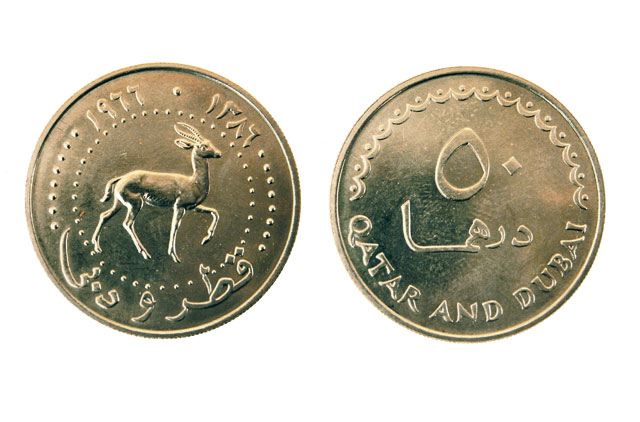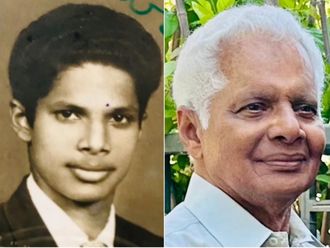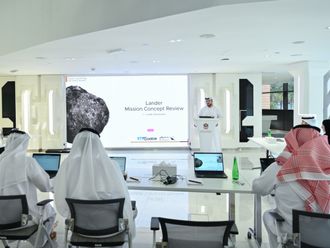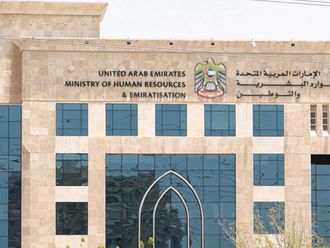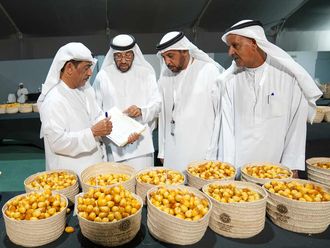
From the earliest times, the Arabian Gulf has been a hub of cross-cultural and trans-regional trade and commerce. The continuation of oceanic trade links for over two millennia meant that coins from various parts of the world circulated freely in the Gulf. Even names we use now are derived from such coins — dirham comes from the Greek word ‘drachma’, while riyal is the Arabic equivalent of the Spanish word ‘real’, which means royal.
The earliest coins in the region reflect its connections with the rest of the world. They bear designs copied from coins of Alexander the Great — a young Heracles wearing the Nemean lion’s scalp on one side, and the Greek god Zeus seated on his throne on the other. The execution of these motifs, however, show either such deterioration or so much stylisation that the original motifs are only barely recognisable. Some of these coins have an inscription in the Aramaic script mentioning the name of Ab’iel, a local ruler. These coins take the monetary history of the UAE back to the third century BCE (Before the Common Era, i.e. third century BC). They have been found in excavations at ancient sites such as Mleiha in Sharjah and ed-Dur in Umm Al Quwain.
The trade links of the Indian subcontinent with the horn of Arabia also date back to antiquity. The area is mentioned in a first-century AD Greek manual of seafaring, named the Periplus of the Erythraean Sea that describes in detail the journey, the ports of call and the merchandise that constituted trade between India and Rome in the first century AD. The discovery of a gold coin that can be traced to the Roman emperor Tiberius at ed-Dur proves the circulation of Roman coins in the region. Coins of the Western Ksatrapa dynasty of Gujarat, dating to the first century CE (Common Era or first century AD), have been unearthed at Mleiha.
Early Islamic armies used the area around the tip of the horn of Arabia as a base to launch expeditions against the Sasanians of Iran to the north and to the Sultanate of Oman to the south. Indeed, the earliest coins of a purely Islamic design from the region are of the Umayyad dynasty, minted at Uman Al Wusta (Oman) dated to AH 90 (AH stands for Anno Hegirae, the Islamic era). In the tenth century the area came under the control of the Buwayhid dynasty of Iran — evidence to this effect has been found in Ras Al Khaimah, where a hoard of Samanid and Buwayhid silver coins was found in 1965. With its strategic location, the ancient UAE had close trade links with many sites across the Arabian Gulf, including Siraf on the Iranian coast and Sohar in Oman. During the 13th and 14th centuries AD, the kingdom of Hormuz controlled the region. Its coins have been found in excavations at Julfar in Ras Al Khaimah. They bear the name Jarun, which was the original name of the island of Hormuz, where the coins were minted between the 14th and 16th centuries.
Trading interests in the Gulf
The Age of Sail during the 16th and 17th centuries saw the presence of many European trading interests in the Gulf. As silver was the preferred mode of currency, the Europeans brought with them many contemporary silver coins, some of them from places as far as Mexico and Colombia. Almost all of these silver coins would later become known later as a dollar. The Spanish real de a ocho or piece of eight, commonly known as the Spanish dollar, was one of them and ended giving its name to many national currencies in the region.
Some coins, such as the Maria Theresa dollar and the Indian rupee were preferred by traders for their standard and highly reliable silver contents. The Maria Theresa dollar was struck in the late 18th century by the Habsburg Empire in Austria and had the bust of Empress Maria Theresa impressed upon it. In the mid-20th century the demand for Maria Theresa dollars was so high that a French entrepreneur based in Aden named Antonin Besse persuaded the British coin manufacturers Royal Mint to strike these long obsolete coins in large numbers so they could be traded within Arabia and East Africa. While the first of these coins were struck in London, the outbreak of the Second World War made shipping lines to the Gulf too risky to operate and production was moved to the Bombay mint. Within a short span of four years, the Bombay mint struck more than 1.9 million Maria Theresa dollars for trade in Arabia.
The truce treaty with the British in 1853 meant a boost to the circulation of the Indian rupee in the Gulf. In much of the latter part of the 19th century and the first decades of the 20th century, the Indian rupee emerged as the legal tender of the region. The economic sphere of influence of the Indian rupee extended well beyond the boundaries of the subcontinent — to the Gulf, South Arabia, the Red Sea region and the eastern coast of Africa.
In 1935, the Reserve Bank of India (RBI) was established as the central monetary authority for what was called the Indian Empire by the British. Treaty obligations with the Gulf states meant that the RBI also managed the currency of the region. The Indian rupee was floated as the legal tender in the Gulf against a portion of metallic reserve held by the RBI. After Indian Independence in 1947, it was decided to make the Indian rupees in circulation in the Gulf redeemable to the RBI in foreign exchange equivalent.
The big problem
This gave rise to a problem in the 1950s. The foreign exchange reserves of India were low and to contain the drain on precious metal resources, the Indian government severely restricted trade in gold and silver. The price of gold in India went up and Gulf souqs were seen as a lucrative source of the yellow metal.
Having a currency that one could use on both shores of the Arabian Sea helped. Rupees used to buy gold in the Gulf were redeemed by the RBI in hard currency, which meant the RBI was paying for smuggled gold through its foreign exchange reserves.
The solution to the problem was found by the RBI in 1959 — it decided to launch a special series of rupee notes that could circulate only in the Gulf. They were called External Rupee or Gulf Rupee notes. As such the circulation of the rupee in the Gulf could be monitored and differentiated from the internal accounting of currency circulating within India.
These notes looked exactly the same as the Indian notes, except they were printed in a different colour and were cashable only at the RBI’s Bombay office of issue. Such an instance — a central monetary authority of one country sequestering its own currency for use in another country — is unique in the monetary history of the world.
Creation of a new currency
The exploration of crude oil reserves in the Gulf during the 1960s gave nations in the region the opportunity to launch their own currencies. Also, Britain was heading towards the end of its protectorate over the Gulf. In 1965, a decision to abandon the Indian rupee as the legal tender was taken. An Arabian Gulf Currency Agreement was signed on July 7, 1965, but its implementation was not smooth — Qatar and Dubai decided to form a monetary union, while Abu Dhabi made the Bahraini dinar its own currency. The Qatar and Dubai monetary union were to have its own riyal, equivalent to 1.5 shillings sterling.
Shortly before the new currency was launched, the Indian government devalued the rupee (June 7, 1966), creating a chaos in the Gulf money market. With the banks within the Gulf states exchanging Gulf rupees at the pre-devaluation rates, the Gulf states had to protect themselves from speculators. The Gulf rupees were withdrawn and substituted with Saudi riyals. By September 1966, the new currency was available in sufficient quantities and this put an end to the circulation of the Indian rupee.
The Qatar and Dubai monetary union existed until the formation of the United Arab Emirates in 1971. Its coins were designed by Christopher Ironside of the Royal Mint and struck in Britain. They came in denominations of one, two, five, ten, 25, and 50 dirhams. The banknotes of the union were printed by Bradbury Wilkinson & Co, also a British banknote printing firm. They were of one, two, five, ten, 20, 50 and 100 riyals. They had similar designs — a vignette of a dhow, an oil rig and palm trees in a roundel. A falcon’s head appeared as a watermark in the specially provided window. The notes bore the signature of Shaikh Khalifa Bin Hamad Al Thani, Chairman of the Qatar and Dubai
Currency Board.
The Gulf rupee notes, with their short history, are rare to come by. The 100-rupee note is the rarest and one was sold in an auction held in Hyderabad, India, this July for more than 300,000 Indian rupees (about Dh22,038).
— Shailendra Bhandare is the Acting Keeper, Heberden Coin Room, Ashmolean Museum, University of Oxford. Email shailendra.bhandare@ashmus.ox.ac.uk


